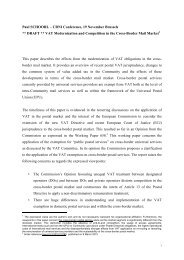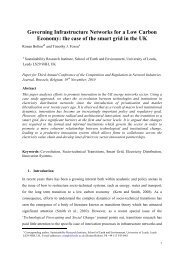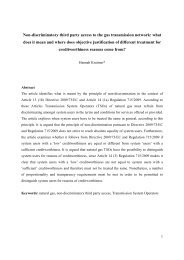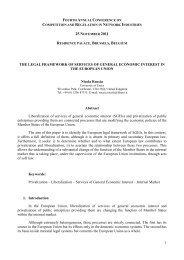Regulatory Incentives for Investments in Electricity Networks - CRNI ...
Regulatory Incentives for Investments in Electricity Networks - CRNI ...
Regulatory Incentives for Investments in Electricity Networks - CRNI ...
Create successful ePaper yourself
Turn your PDF publications into a flip-book with our unique Google optimized e-Paper software.
External effects can also be <strong>in</strong>cluded <strong>in</strong> the cost-benefit analysis. For example an expansion of<br />
the transmission system can br<strong>in</strong>g substantial environmental benefits by avoid<strong>in</strong>g air emissions<br />
otherwise caused by local generation and by reduc<strong>in</strong>g the need to procure local air offsets needed<br />
<strong>for</strong> generation. 17 If the environmental costs are <strong>in</strong>ternalised (i.e. <strong>in</strong>cluded <strong>in</strong> the <strong>in</strong>vestments costs<br />
and <strong>in</strong> the operation and ma<strong>in</strong>tenance costs) the benefits will be automatically accounted <strong>for</strong> via<br />
the avoided costs. If it is not the case, they should be additionally quantified provided that<br />
sufficient <strong>in</strong><strong>for</strong>mation is available.<br />
4.2 H<strong>in</strong>dsight Efficiency Analysis Us<strong>in</strong>g Total Costs<br />
Under this approach, the problem of <strong>in</strong>vestment assessments is effectively bypassed. The<br />
regulator does not need to <strong>for</strong>m an op<strong>in</strong>ion on whether a given <strong>in</strong>vestment proposal should be<br />
allowed or not. Rather, the regulator considers the actual total costs (<strong>in</strong>clud<strong>in</strong>g the capital costs<br />
of new <strong>in</strong>vestments) <strong>in</strong>curred by the network operator and sets the efficiency <strong>in</strong>crease factor<br />
based on an efficiency assessment (benchmark<strong>in</strong>g) of these costs.<br />
The efficiency assessment can be made by compar<strong>in</strong>g the exist<strong>in</strong>g companies and us<strong>in</strong>g<br />
traditional benchmark<strong>in</strong>g techniques, such as Data Envelopment Analysis (DEA), Corrected<br />
Ord<strong>in</strong>ary Least-Squire (COLS) or Stochastic Frontier Analysis (SFA). When the data sample is<br />
small or <strong>in</strong>complete, such techniques cannot be applied effectively. Eng<strong>in</strong>eer<strong>in</strong>g network models<br />
provide an alternative approach that can be used to fill the gap that traditional benchmark<strong>in</strong>g<br />
techniques cannot cover. In contrast to the traditional techniques, eng<strong>in</strong>eer<strong>in</strong>g network models do<br />
not rely on exist<strong>in</strong>g alternative options, but rather create these options on the basis of<br />
predeterm<strong>in</strong>ed economic and eng<strong>in</strong>eer<strong>in</strong>g criteria.<br />
The efficiency <strong>in</strong>centives of this approach come from the fact that <strong>in</strong> each regulatory period, the<br />
efficiency <strong>in</strong>crease requirements are set on the basis of per<strong>for</strong>mance achieved <strong>in</strong> previous years.<br />
If the firm manages to <strong>in</strong>crease productivity, its efficiency score will be higher <strong>in</strong> future periods<br />
and consequently the required efficiency <strong>in</strong>crease will be lower. An additional advantage of this<br />
approach is that it provides an <strong>in</strong>centive to the service provider to be <strong>in</strong>different to the mix of<br />
<strong>in</strong>puts and to deliver its required output at the lowest total cost.<br />
The threat that capital costs of <strong>in</strong>vestments may be rejected, or partially disallowed, <strong>in</strong> the<br />
process of benchmark<strong>in</strong>g provides an <strong>in</strong>centive to the regulated company to only undertake<br />
efficient <strong>in</strong>vestment. Such an <strong>in</strong>centive is considered necessary because the regulated company is<br />
likely to hold better <strong>in</strong><strong>for</strong>mation than the regulator about the prospective efficiency of a proposed<br />
<strong>in</strong>vestment. There<strong>for</strong>e, by mak<strong>in</strong>g the company accept the consequences of its <strong>in</strong>vestment<br />
decisions, the probability that <strong>in</strong>efficient <strong>in</strong>vestment will take place is weakened. On the other<br />
hand, the regulatory threat that capital costs of <strong>in</strong>vestments can be disallowed due to the ex-post<br />
benchmark<strong>in</strong>g could discourage regulated companies from implement<strong>in</strong>g even good <strong>in</strong>vestment<br />
projects. Also, there may be capital expenditure that is planned and conducted <strong>in</strong> good faith that<br />
eventually proves “imprudent” on an ex-post basis. Moreover, the credibility of the efficiency<br />
analysis depends on the data quality, adequacy of the model specification and the robustness of<br />
17 Such reductions may also have secondary effects. They may assist <strong>in</strong> allow<strong>in</strong>g new <strong>in</strong>dustries with higher<br />
economic value to enter the local area by avoid<strong>in</strong>g negative impacts to the local water and natural gas supplies<br />
otherwise required <strong>for</strong> local generation. Also transmission upgrade may reduce the construction of additional<br />
<strong>in</strong>frastructures such as gas pipel<strong>in</strong>es, pump<strong>in</strong>g stations, and water and waste treatment systems.<br />
12







